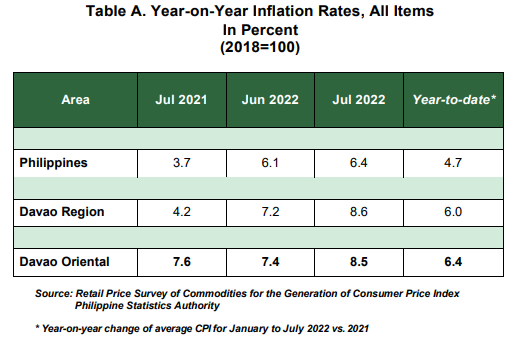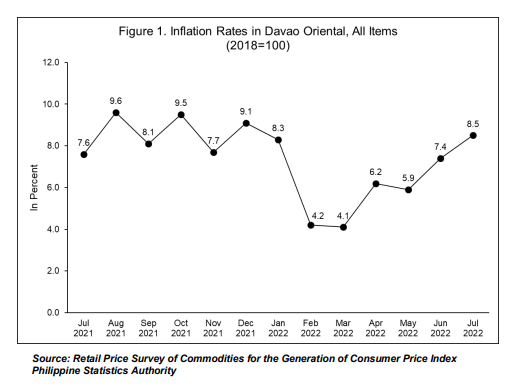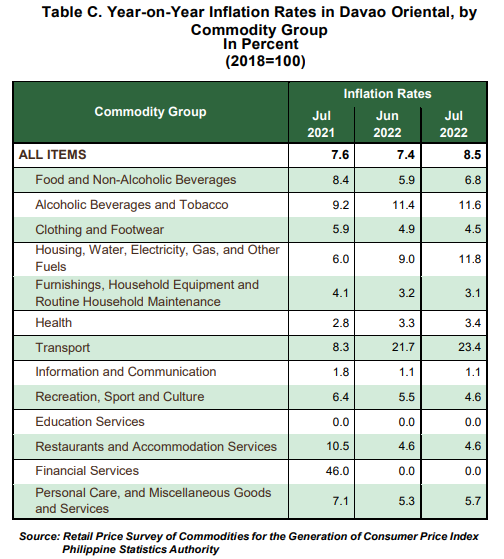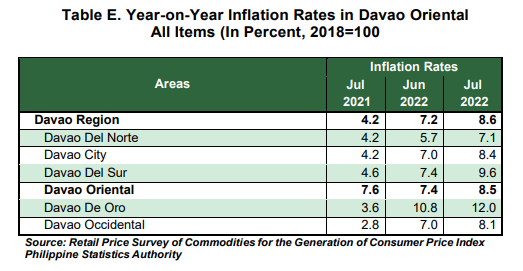
The inflation in Davao Oriental further accelerated to 8.5 percent in July 2022. This is 1.1 percentage points higher than the 7.4 percent inflation recorded in the previous month. In July 2021, inflation in the province was observed at 7.6 percent. This is the highest inflation recorded since January 2022. The average inflation for the first seven months of the year stood at 6.4 percent. (Table A and B, and Figure 1)

The increase in the province’s inflation was mainly brought by the surge in the annual increments of the heavily weighted index for food and nonalcoholic beverages at 6.8 percent from 5.9 percent in the previous month. The index for food and non-alcoholic beverages contributed 42.0 percent to the province’s inflation. Additionally, the annual increments in the indices of transport (23.4 percent) and housing, water, electricity, gas, and other fuels (11.8 percent) ranked as second and third largest contributors to the province’s inflation at 23.3 percent and 21.5 percent, respectively. The following indices also showed an upward trend during the period:
- Alcoholic Beverages and Tobacco, 11.6 percent;
- Personal Care, and Miscellaneous Goods and Services, 5.7 percent; and
- Health, 3.4 percent\
Meanwhile, inflation rates in the indices of recreation, sport and culture (4.6 percent), clothing and footwear (4.5 percent) and furnishings, household equipment and routine household maintenance (3.1 percent) decreased during the period.The rest of the commodity groups either retained their previous month’s inflation rates or had zero percent annual growths. (Table C)

Moreover, the annual increments for food index increased further by 0.8 percentage points from 6.0 percent in the preceding month to 6.8 percent in July 2022. In July 2021, inflation for food index was observed at 8.9 percent. (Table D)
The annual growth rate of meat and other parts of slaughtered land animals accelerated to 10.2 percent from 9.4 percent in the previous month. This food group was the highest contributor to inflation this month at 22.4 percent. This was followed by fish and other seafood (4.9 percent) and sugar, confectionery and desserts (39.9 percent) which contributed 15.3 percent and 12.8 percent, respectively. Milk, other dairy products and eggs (7.5 percent) and ready-made food and other food products n.e.c. (5.0 percent) also exhibited an upward trend during the month.
Although vegetables, tubers, plantains, cooking bananas and pulses (19.3 percent) had a downward trend during the month, it still contributed 20.1 percent to the province’s inflation. Additionally, the inflation rates of the following food groups also decreased during the period:
a. Rice, 2.3 percent;
b. Corn, -2.4 percent;
c. Oils and fats, 6.7 percent; and
d. Fruits and nuts, 1.8 percent.
Flour, Bread And Other Bakery Products, Pasta Products, and Other Cereals (8.3 percent) retained its previous month’s inflation.

During the period, Davao Oriental’s inflation was lower than Davao Region’s average of 8.6 percent but higher than the country’s average of 6.4 percent.
Among provinces and highly urbanized city in Davao Region, Davao Oriental’s inflation of 8.5 percent ranked as the third highest next to Davao de Oro’s 12.0 percent and Davao del Sur’s 9.6 percent. Davao del Norte’s inflation is the lowest in the region at 7.1 percent. Davao City and Davao Occidental had an inflation rate of 8.4 percent and 8.1 percent, respectively. (Table E)

Purchasing Power of Peso (PPP) further decreased to 84 centavos
Purchasing Power of Peso (PPP) shows how much the peso in the base period is worth in the current period. It is computed as the reciprocal of the CPI for the period under review multiplied by 100. The PPP is inversely related to inflation rate. Thus, as the inflation rate increases, PPP declines.
The PPP in July 2022 further decreased to 84 centavos from 86 centavos in June 2022. This means that the amount of Php100.00 in 2018 is equivalent to Php84.25 in July 2022. Similarly, you will need Php118.70 to purchase the same set of goods and services worth Php100.00 in 2018. In July 2021, the PPP was at 91 centavos. (Figure 2)


TECHNICAL NOTES
Uses of CPI
The CPI is most widely used in the calculation of the inflation rate and purchasing power of peso. It is a major statistical series used for economic analysis and as a monitoring indicator of government economic policy.
Computation of CPI
The computation of the CPI involves consideration of the following important points:
a. Base Period - The reference date or base period is the benchmark or reference date or period at which the index is taken as equal to 100.
b. Market Basket - A sample of the thousands of varieties of goods purchased for consumption and services availed by the households in the country selected to represent the composite price behavior of all goods and services purchased by consumers.
c. Weighting System - The weighting pattern uses the expenditures on various consumer items purchased by households as a proportion to total expenditure.
d. Formula - The formula used in computing the CPI is the weighted arithmetic mean of price relatives, the Laspeyre’s formula with a fixed base year period (2006) weights.
e. Geographic Coverage - CPI values are computed at the national, regional, and provincial levels, and for selected cities.
Note: CPIs and inflation rates by province and selected city are posted at the PSA website (https://openstat.psa.gov.ph/).
Approved for release:
ROGELIO T. LEBRIA
Chief Statistical Specialist
